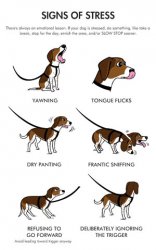How to give training to dog?
 You’re walking your dog when an off-leash Lab puppy comes sprinting your way. Knowing that your dog is about to freak out, you shout, “Call your dog!” in the vain hope that the caregiver will (a) call her puppy and (b) actually be able to get the puppy under control. The common response, “Don’t worry, she’s friendly!” sends your pulse soaring.
You’re walking your dog when an off-leash Lab puppy comes sprinting your way. Knowing that your dog is about to freak out, you shout, “Call your dog!” in the vain hope that the caregiver will (a) call her puppy and (b) actually be able to get the puppy under control. The common response, “Don’t worry, she’s friendly!” sends your pulse soaring.
It’s meant to reassure you, but few phrases are more terrifying when you know your dog is going to bark, lunge or worse.
What do you do? Outdated training advice directs you to just hold your ground until your dog goes berserk, then correct him with a hefty leash pop. That might make you feel like you’re doing something about the problem, but it’s actually not the best time to teach your dog a lesson. To get a predictable response, build up your dog’s experience with success, not failure.
The only thing a correction tells your dog is to put up and shut up. That doesn’t make him feel any better, but he may stop growling—in other words, stop warning you when he’s feeling uncomfortable. It’s like taking the batteries out of your smoke alarm instead of dealing with the fire. Shutting off your dog’s warning system makes his behavior more unpredictable and, therefore, dangerous.
Instead of giving a correction, or even trying to feed your soon-to-explode dog, the best thing to do is to calmly (but quickly) get your dog out of there. For long-term change, do some specific training that’s proactive, not reactive.
You do not need the violent corrections that you may have seen on television, nor do you need to always stuff your dog with treats. Since 2010, Behavior Adjustment Training (BAT) has helped many dogs and their people around the world lead more normal lives. An updated version of BAT first appeared at seminars in 2014 and is now described in BAT 2.0 (available mid- February in e-book and print versions).
With BAT, trainers set up scenarios similar to situations that would cause a reaction, but are different enough that the dog can explore the area and learn about the trigger at his own pace. BAT gives dogs a reality check. Dogs who would usually overreact have a chance to slow down and learn from experiences that contradict their negative expectations.
Related posts:

 Training your dog to do advanced tricks like finding something or bringing their food bowl can be done with just 10 minutes a day and some clicker training. It’s…
Training your dog to do advanced tricks like finding something or bringing their food bowl can be done with just 10 minutes a day and some clicker training. It’s… 6 Principles of Successful Training 1. Be Consistent: Apply the same rules and the same words all the time. 2. Be Concise: Give your command just once. Repetition…
6 Principles of Successful Training 1. Be Consistent: Apply the same rules and the same words all the time. 2. Be Concise: Give your command just once. Repetition… Cesar Millan Cesar is a best-selling author, public speaker, and internationally acclaimed star of the TV shows “Dog Whisperer with Cesar Millan, ” “Leader of the…
Cesar Millan Cesar is a best-selling author, public speaker, and internationally acclaimed star of the TV shows “Dog Whisperer with Cesar Millan, ” “Leader of the… At Monument Dog Training, we believe that change is always possible . We regularly resolve aggressive behavioral issues, even with dogs who have been written off…
At Monument Dog Training, we believe that change is always possible . We regularly resolve aggressive behavioral issues, even with dogs who have been written off… After years of working with thousands of dogs and their owners, I have seen that the key ingredient people are actually looking for is how to be the Pack Leader…
After years of working with thousands of dogs and their owners, I have seen that the key ingredient people are actually looking for is how to be the Pack Leader…